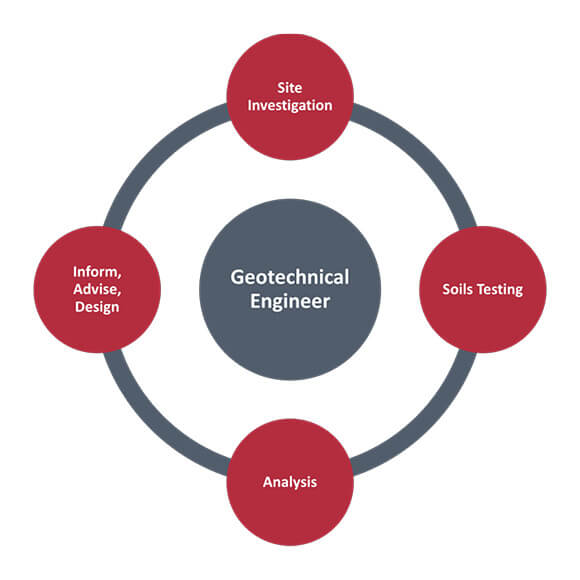The Definitive Guide for Geotheta
Table of ContentsLittle Known Questions About Geotheta.How Geotheta can Save You Time, Stress, and Money.The Best Guide To GeothetaAll About GeothetaThe Only Guide for Geotheta

They perform site investigations, gather samples, carry out research laboratory tests, and evaluate data to review the viability of the ground for building projects - Tailings Engineer. Based upon their searchings for, geotechnical designers supply referrals for foundation layout, slope security, preserving structures, and reduction of geotechnical risks. They team up with various other professionals, such as engineers, structural engineers, and building and construction groups, to make sure that geotechnical considerations are integrated into the total project layout and application
By examining the habits and residential or commercial properties of dirt and rock, they can recognize potential geotechnical hazards such as landslides, soil settlement, or incline instability. Their knowledge aids prevent failings or crashes that could endanger lives and home. Right here are some detailed duties and responsibilities of a geotechnical designer: Website Investigation: Geotechnical engineers conduct site examinations to gather information on subsurface problems.
They translate the data to comprehend the buildings and habits of the dirt and rock, including their toughness, permeability, compaction characteristics, and groundwater conditions. Geotechnical Evaluation and Style: Geotechnical engineers assess the data accumulated during website examinations to analyze the security and suitability of the website for building and construction tasks. They do geotechnical calculations and modeling to review aspects such as bearing ability, negotiation, incline security, lateral planet stress, and groundwater flow.
Everything about Geotheta
Foundation Style: Geotechnical designers play a vital role in making foundations that can safely support the designated structure. They examine the dirt conditions and lots requirements to identify the suitable structure type, such as shallow foundations (e.g., grounds), deep foundations (e.g (https://www.blogtalkradio.com/geotheta)., stacks), or specialized techniques like dirt renovation. They consider elements such as negotiation limitations, birthing capacity, and soil-structure communication to develop optimum foundation designs
They evaluate building strategies, monitor website activities, and conduct area evaluations to verify that the layout suggestions are complied with. If unpredicted geotechnical issues develop, they assess the situation and offer suggestions for remediation or modifications to the style. Threat Evaluation and Mitigation: Geotechnical designers analyze geotechnical dangers and threats linked with the task website, such as landslides, liquefaction, or dirt disintegration.

Cooperation and Communication: Geotechnical designers work carefully with various other specialists involved in a project, such as engineers, structural designers, and construction groups. Efficient interaction and partnership are crucial to integrate geotechnical factors to consider into the general task layout and construction process. Geotechnical engineers give technological knowledge, answer questions, and make certain that geotechnical demands are satisfied.
Unknown Facts About Geotheta
Right here are some sorts of geotechnical engineers: Foundation Designer: Foundation engineers specialize in creating and evaluating foundations for structures. They evaluate the dirt problems, tons requirements, and site features to establish the most suitable foundation kind and design, such as shallow structures, deep foundations, or specialized strategies like stack foundations.
They assess the aspects influencing slope stability, such as dirt properties, groundwater problems, and go to these guys slope geometry, and develop techniques to prevent incline failures and minimize risks. Earthquake Engineer: Quake engineers focus on examining and creating structures to withstand seismic forces. They examine the seismic danger of a site, assess dirt liquefaction capacity, and establish seismic style criteria to ensure the safety and security and resilience of frameworks throughout earthquakes.
They do field testing, accumulate examples, and analyze the accumulated data to define the soil residential properties, geologic developments, and groundwater problems at a site. Geotechnical Instrumentation Engineer: Geotechnical instrumentation designers concentrate on monitoring and gauging the behavior of dirt, rock, and structures. They mount and maintain instrumentation systems that keep an eye on factors such as dirt settlement, groundwater levels, incline activities, and architectural displacements to analyze efficiency and supply early warnings of prospective problems.
Things about Geotheta
They conduct tests such as triaxial tests, loan consolidation examinations, straight shear examinations, and permeability tests to collect information for geotechnical evaluation and style. Geosynthetics Designer: Geosynthetics designers specialize in the style and application of geosynthetic products, such as geotextiles, geogrids, and geomembranes. They use these materials to improve soil stability, strengthen inclines, provide drainage remedies, and control erosion.
They have a tendency to be investigative individuals, which indicates they're intellectual, reflective, and inquisitive. They are curious, systematic, rational, logical, and sensible. Some of them are likewise social, suggesting they're kind, charitable, cooperative, person, caring, handy, compassionate, skillful, and friendly - Consulting Engineer.
In the office setting, geotechnical designers make use of specialized software program tools to carry out estimations, create layouts, and analyze data. They prepare records, review job specifications, communicate with customers and employee, and coordinate job tasks. The workplace setting gives a helpful environment for research study, analysis, and partnership with other experts associated with the task.
Not known Details About Geotheta
They regularly see job websites to perform website examinations, assess geotechnical conditions, and collect data for analysis. These brows through entail taking a trip to various locations, sometimes in remote or tough terrains. Geotechnical engineers might do dirt sampling, conduct tests, and monitor construction tasks to guarantee that the geotechnical elements of the job are being executed correctly.
Geotechnical designers also function in specialized geotechnical research laboratories. Geotechnical research laboratory engineers function extensively in these settings, managing testing tools, running instruments, and recording data.